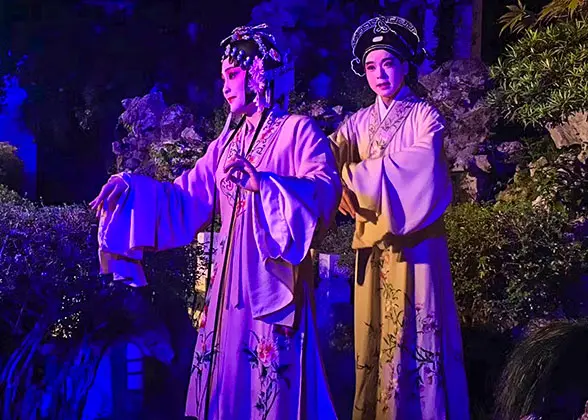Kunqu Opera
 |
| Kunqu Opera |
Over 600 Years’ History of Kunqu Opera
Kunqu Opera was originally developed in Kunshan over 600 years ago. It outshone other opera styles for 300 years in ancient times. Its tune was improved by folk musician Wei Liangfu in the 1500s during the Ming Dynasty (1368 - 1644 AD). Later, in the middle of the Qing Dynasty (1644 - 1911 AD), it began to decline. There was no professional team to perform Kun Opera before 1949. Until 1950, six Kunqu Opera troupes were established one after another. Now, there are 8 troupes of Kunqu Opera in mainland China. In 2001, Kunqu Opera became a world cultural heritage. The renaissance of Kunqu Opera is going on, though it is progressing slowly.
Features of Kunqu Opera
Kunqu Opera has a strict and complete system of its own for the artistic presentations of singing, dancing, speaking, etc. The most obvious feature of Kunqu Opera is strong lyricism, which asks performers to pay close attention to the details of each posture and each voice. The dances in Kunqu Opera adopted the folk and court dances of ancient times, to match up with the whole drama harmoniously. The famous plays of Kunqu Opera were almost all written in ancient times, thus all words are spoken or sung in Classical Chinese. In this way, Kun Opera is seen as a living descendant of Chinese classical operas.
3 Main Types of Roles
Dan - Female Roles
Dan roles are usually made up to be beautiful with white skin and rosy checks. They include Lao Dan - old females, Zheng Dan - brave married females of integrity, Zuo Dan - girl children, Cisha Dan - also called Si Dan, the females who take action to kill someone in secret, Guimen Dan - young girls who begin to think of love, or newly married females, Tie Dan - also Liu Dan, lively and frank girls of humble background, such as servant girls, and Wu Dan - females who play martial works.
Sheng - Male Roles
With the simplest makeup of all the roles, Sheng refers to male roles. In the performances of Kunqu Opera, there are Lao Sheng or Zheng Sheng - elderly males, Wai - older males with long, white facial hair, Mo - elderly males of lower class, with dense black facial hair, Guan Sheng - adult male officers, and Wu Sheng - young male fighters, Jin Sheng - male intellectuals, Zhiwei Sheng - male roles who wear pheasant feathers on their heads and Xiepi Sheng - poor Confucian scholars.
Jing and Chou - Special Roles
Jing and Chou are two kinds of male roles in Kunqu Opera that are painted with exaggerated and colorful patterns on their faces. Jing is composed of Wen Jing - mighty men, Wu Jing - straightforward and brute-force men and Bai Mian - vicious men that are painted white.
Traditional Chinese Costume
The costumes for Kunqu Opera performers are the traditional ones from the Yuan and Ming (1271 - 1644 AD) Dynasties. There are more than 20 kinds of costumes, including official robes, uniform robes for officers, cloaks and pleats. These clothes are usually made of silk, satin, or plain cloth, embroidered with the patterns of dragons, phoenixes, birds, animals, fish, flowers, clouds, water and so on. The colors are primarily red, yellow, blue, white, black, purple, and pink, which are bright and colorful.
Shuimo Tune – The Main Singing Tune of Kunqu Opera
Shuimo Tune, also called Kunshan Tune, is the major tune of Kun Opera. It evolved in the late Yuan Dynasty (1271 - 1368 AD). Based on the folk music of south China, and absorbing characteristics of the ballads of the north, Shuimo Tune sounds soft, sweet and mellow with long syllables and flowery language. The performers usually sing the words slowly. It is quite affectionate, like the process of grinding rice with water, thus it was named as Shuimo, literally meaning grinding rice grains with a water mill. It makes people feel pleasant and relaxed.
Accompaniment of Classical Chinese Musical Instruments
When performed, Kunqu Opera is accompanied by various kinds of classical instruments such as the Chinese flute, Xiao (a vertical bamboo flute), clappers, Pipa (4-stringed Chinese lute), Sanxian (a three-stringed plucked instrument), gong and drum.
Where to Watch Kunqu Opera
Chinese Name: 中国昆曲博物馆
Address: inside Suzhou Opera Museum, No.14, Central Zhangjia Alley, Gusu District, Suzhou
Chinese Name: 山塘昆曲馆
Address: No.45, Xiatang, Tonggui Bridge, Shantang Street, Gusu District, Suzhou
Chinese Name: 小河驿昆曲国际会客厅
Address: No. 31, Xiaohezhi Street, Gongshu District, Hangzhou
Chinese Name: 上海昆剧团
Address: No.9, Shaoxing Road, Huangpu District, Shanghai
Chinese Name: 梅兰芳大剧院
Address: No.32, West Street, Ping’an Li, Xicheng District, Beijing